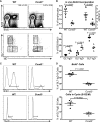Cyclin D3 is selectively required for proliferative expansion of germinal center B cells
- PMID: 20956554
- PMCID: PMC3019862
- DOI: 10.1128/MCB.00650-10
Cyclin D3 is selectively required for proliferative expansion of germinal center B cells
Abstract
The generation of robust T-cell-dependent humoral immune responses requires the formation and expansion of germinal center structures within the follicular regions of the secondary lymphoid tissues. B-cell proliferation in the germinal center drives ongoing antigen-dependent selection and the generation of high-affinity class-switched plasma and memory B cells. However, the mechanisms regulating B-cell proliferation within this microenvironment are largely unknown. Here, we report that cyclin D3 is uniquely required for germinal center progression. Ccnd3(-/-) mice exhibit a B-cell-intrinsic defect in germinal center maturation and fail to generate an affinity-matured IgG response. We determined that the defect resulted from failed proliferative expansion of GL7(+) IgD(-) PNA(+) B cells. Mechanistically, sustained expression of cyclin D3 was found to be regulated at the level of protein stability and controlled by glycogen synthase kinase 3 in a cyclic AMP-protein kinase A-dependent manner. The specific defect in proliferative expansion of GL7(+) IgD(-) PNA(+) B cells in Ccnd3(-/-) mice defines an underappreciated step in germinal center progression and solidifies a role for cyclin D3 in the immune response, and as a potential therapeutic target for germinal center-derived B-cell malignancies.
Figures







Similar articles
-
Requirement for cyclin D3 in germinal center formation and function.Cell Res. 2010 Jun;20(6):631-46. doi: 10.1038/cr.2010.55. Epub 2010 Apr 20. Cell Res. 2010. PMID: 20404856 Free PMC article.
-
Cyclin D3 Governs Clonal Expansion of Dark Zone Germinal Center B Cells.Cell Rep. 2020 Nov 17;33(7):108403. doi: 10.1016/j.celrep.2020.108403. Cell Rep. 2020. PMID: 33207194 Free PMC article.
-
TLR7, a third signal for the robust generation of spontaneous germinal center B cells in systemic lupus erythematosus.Cell Mol Immunol. 2018 Mar;15(3):286-288. doi: 10.1038/cmi.2017.123. Epub 2017 Nov 27. Cell Mol Immunol. 2018. PMID: 29176742 Free PMC article. No abstract available.
-
System-Level Scenarios for the Elucidation of T Cell-Mediated Germinal Center B Cell Differentiation.Front Immunol. 2021 Sep 20;12:734282. doi: 10.3389/fimmu.2021.734282. eCollection 2021. Front Immunol. 2021. PMID: 34616402 Free PMC article. Review.
-
T-cell subsets in the germinal center.Immunol Rev. 2013 Mar;252(1):146-55. doi: 10.1111/imr.12031. Immunol Rev. 2013. PMID: 23405902 Review.
Cited by
-
Lymphocyte lineage-specific and developmental stage specific mechanisms suppress cyclin D3 expression in response to DNA double strand breaks.Cell Cycle. 2016 Nov;15(21):2882-2894. doi: 10.1080/15384101.2016.1198861. Epub 2016 Jun 21. Cell Cycle. 2016. PMID: 27327568 Free PMC article.
-
Dynamics of B cells in germinal centres.Nat Rev Immunol. 2015 Mar;15(3):137-48. doi: 10.1038/nri3804. Epub 2015 Feb 6. Nat Rev Immunol. 2015. PMID: 25656706 Free PMC article. Review.
-
Paradoxical role of Id proteins in regulating tumorigenic potential of lymphoid cells.Front Med. 2018 Aug;12(4):374-386. doi: 10.1007/s11684-018-0652-x. Epub 2018 Jul 24. Front Med. 2018. PMID: 30043222 Review.
-
Gsk3 is a metabolic checkpoint regulator in B cells.Nat Immunol. 2017 Mar;18(3):303-312. doi: 10.1038/ni.3664. Epub 2017 Jan 23. Nat Immunol. 2017. PMID: 28114292 Free PMC article.
-
Differing Requirements for MALT1 Function in Peripheral B Cell Survival and Differentiation.J Immunol. 2017 Feb 1;198(3):1066-1080. doi: 10.4049/jimmunol.1502518. Epub 2016 Dec 28. J Immunol. 2017. PMID: 28031341 Free PMC article.
References
-
- Allen, C. D., T. Okada, H. L. Tang, and J. G. Cyster. 2007. Imaging of germinal center selection events during affinity maturation. Science 315:528-531. - PubMed
-
- Basso, K., M. Saito, P. Sumazin, A. A. Margolin, K. Wang, W. K. Lim, Y. Kitagawa, C. Schneider, M. J. Alvarez, A. Califano, and R. Dalla-Favera. Integrated biochemical and computational approach identifies BCL6 direct target genes controlling multiple pathways in normal germinal center B cells. Blood 115:975-984. - PMC - PubMed
-
- Basu, U., J. Chaudhuri, C. Alpert, S. Dutt, S. Ranganath, G. Li, J. P. Schrum, J. P. Manis, and F. W. Alt. 2005. The AID antibody diversification enzyme is regulated by protein kinase A phosphorylation. Nature 438:508-511. - PubMed
Publication types
MeSH terms
Substances
Grants and funding
LinkOut - more resources
Full Text Sources
Molecular Biology Databases
